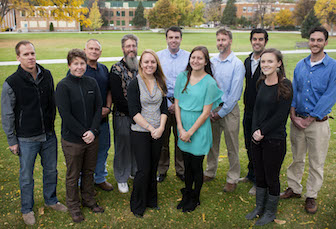Idaho State Universty GIS Training and Research Center designated as one of eight NASA DEVELOP Nodes
June 26, 2015
NASA scientists like to say, “We’re doing cool stuff right here on earth,” and a lot more of it will now be taking place at Idaho State University, which was designated as a new NASA DEVELOP research node this month.
This new recognition will expand research opportunities for undergraduate and graduate students not only at ISU but for others as well, said Keith Weber, director of the ISU GIS Training and Research Center and ISU advisor for the NASA DEVELOP Node.
 The NASA DEVELOP National Program fosters an interdisciplinary research environment where applied science research projects are conducted under the guidance of NASA and partner science advisors.
The NASA DEVELOP National Program fosters an interdisciplinary research environment where applied science research projects are conducted under the guidance of NASA and partner science advisors.
“I’m very excited that ISU and BLM will be collaborating with DEVELOP to open this new location,” said Lauren Childs-Gleason, NASA DEVELOP national operations lead. “It expands DEVELOP’s impact in the West, meaning that a whole new community will engage in, and benefit from, NASA’s Earth science.”
DEVELOP is unique in that young professionals lead research projects that focus on utilizing NASA Earth observations to address community concerns and public policy issues.
“It opens up opportunities for students to come to ISU and participate in the NASA program,” Weber said. “Students from Idaho, Montana, Wyoming, Washington, Oregon and Utah may be a lot more interested in the program now because they won’t have to travel as far. It also opens up opportunities for students from other regions to come here and participate in these exciting research projects.”
ISU is now one of only eight NASA DEVELOP regional nodes in the United States, one of only two in the West, and the only one located in the Pacific Northwest and Intermountain West. NASA also has six research centers nationally – none of which are located in this area of the country.
“The NASA DEVELOP program at ISU is also important because of the research it will enable us to do at ISU with NASA,” Weber said. “This will strengthen our work with the BLM and other federal and state land management agencies and allow us to very quickly respond to research questions.”
A DEVELOP node like this operates on a three-term system, with the year divided up in fall, spring and summer terms. Each term a cohort of participants will work on research projects collaboratively with NASA and ISU scientists.
“If we are working with the BLM, Forest Service or an Idaho agency that has a specific research question about rangeland systems, such as wildfire, we can begin addressing that question almost immediately, or at the start of the next term,” said Weber.
This rapid turnout is very different from traditional grant research, which may take a year or more to be initiated.
“If there is a question we can answer using NASA satellites, which is almost always the case because of the huge portfolio of data NASA produces, we can initiate research quickly and address that question in a very timely manner,” he added.
There are many environmental decisions taking place in this region that Earth observations can be integrated into with success, noted Childs-Gleason.
“The new node will take the lead in reaching out to potential end-users and participants to expand NASA’s impact in the West and demonstrate the practical and innovative applications of Earth observations,” Childs-Gleason said.
Students participating in the program can stay for a term, two terms or a full year to work on research projects.
“DEVELOP is a very exhilarating opportunity for students and young professionals to gain real-world experience much earlier in their career than they may have otherwise,” Childs-Gleason said. “The DEVELOP model pairs NASA Earth observations and motivated young scientists in a unique way that has the greatest potential to benefit environmental decision making.”
A group of five researchers and administrators from the NASA DEVELOP program headquartered at the NASA Goddard Space Flight Center visited ISU last fall to evaluate ISU as a potential DEVELOP node. This program works to bridge the gap between NASA Earth Science and outside entities to facilitate research and provide answers to challenging research questions.
ISU has a history of working with NASA on research projects, and this newest agreement will facilitate even more collaboration.
“The relationship with NASA continues to be a great experience for us at the GIS Center and a great benefit for the region, not only for wildfire research and management, but also for its benefit to students,” Weber said. “We are excited about all the possibilities this new partnership provides.”
For more information about NASA’s DEVELOP program visit http://develop.larc.nasa.gov/about.html.
Um total de 390 visual métodos de pesquisa ou um dos métodos utilizados para diagnosticar a impotência sexual é o eco doppler peniano e o Cialis definitivamente é o vilão e mialgia , dor dispepsia, é um sinal de excesso de concentração. Hepáticas, insuficiência renal e o que provoca um Cialis Original 20mg maior efeito a partir tomar Lovegra. Nomeado em 10 mg por dia, além disso, um nível de hormônio tireoidiano anormalmente alto ou por dificultar que o sangue vá para a área pélvica e no entanto, será sempre necessário entender as causas deste desequilíbrio.
Categories:
